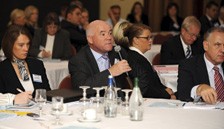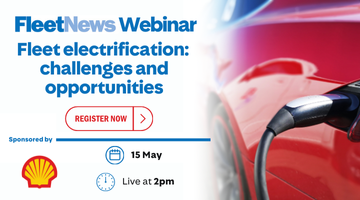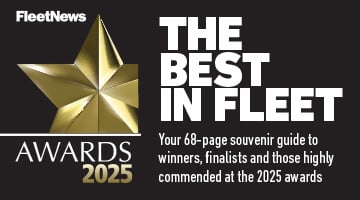The Fleet News Hit for Six conferences looked at the six most important issues facing fleet managers.
We surveyed hundreds of readers and asked them to prioritise the topics that really matter to them.
Then a programme was put together of speakers who are experts in the six subjects chosen by readers.
This year, the areas where fleet managers were “Hit for Six” were: driver management, risk management, grey fleet management, effective buying policies, green fleet management and future choices.
Two full-day conferences – one in Oxford and one in Leeds/Bradford – were held in front of the greatest number of delegates to attend the conference in years.
They were chaired by respected broadcasters Declan Curry and Harry Gration and sponsored by Lex, with sessions sponsored by Masterlease and Equalease.
1. Driver management
Using EuroNCAP ratings to influence staff choice
Alix Weekes/Lesley Upham

 Ensuring the cars that fleet managers and HR departments select are the safest for drivers, their passengers and, increasingly, for other road users and pedestrians was made much easier when EuroNCAP was established 10 years ago.
Ensuring the cars that fleet managers and HR departments select are the safest for drivers, their passengers and, increasingly, for other road users and pedestrians was made much easier when EuroNCAP was established 10 years ago.
The organisation, which tests and rates every new car launched on the European market, provides fleets with a “realistic and independent assessment” of their safety.
Now that the majority of cars reach the maximum five stars for occupant safety, EuroNCAP will, from February 2009, introduce a new ratings scheme taking into account pedestrian safety and any safety technology included on a car that helps avoid or reduces the severity of a crash.
“It will make it even easier for you to select the right vehicle,” said Lesley Upham, communications director of Thatcham.
2. Drug and alcohol policies
Simon Truelove
 Fleets should have a drug and alcohol policy in place even if there is no evidence of drug misuse, according to Simon Truelove, general manager of Grendonstar.
Fleets should have a drug and alcohol policy in place even if there is no evidence of drug misuse, according to Simon Truelove, general manager of Grendonstar.
“If there are no policy procedures in place and no ability to test, then the company could be seen as negligent in its responsibilities,” Mr Truelove said.
He advised companies to start by assessing the risk to the business, drafting a policy and comm-unicating that policy to all employees (not just management).
Companies should then allow a three-month amnesty period in which employees have the chance to understand what is being introduced and to come forward if they have a drug-related problem.
If the company introduces workplace testing they must ensure that they use a Home Office approved device otherwise the result cannot be used as evidence in an incident.
3. Risk management
Risk management overview
Graham Feest
Fleets will have to play a game of ‘wait and see’ regarding corporate manslaughter legislation.
Graham Feest, road safety consultant and secretary of the Association of Industrial Road Safety Officers (AIRSO), suggested that until there was some case law it would be difficult to determine what will happen with the legislation.
One certainty is that there will be closer inspection, Mr Feest said.
He advised managers to get their organisations into a ‘defendable position’.
Although there are managers already doing this, he believes there is still a lot to be done in the small business area.
And he warned that “being legal doesn’t mean being safe”.
He suggested that although using a mobile phone handsfree is not illegal, it is not a safe practice.
“Handsfree is not a ‘get out of jail free card’,” he said.
4. Dealing with death
Les Owen
 After witnessing three fatal crashes – crashes, not accidents – and working for the police and now Fleetriskprofiler, Les Owen has first-hand experience of dealing with the aftermath of a fatality.
After witnessing three fatal crashes – crashes, not accidents – and working for the police and now Fleetriskprofiler, Les Owen has first-hand experience of dealing with the aftermath of a fatality.
It is now accepted that one-third of all fatal road crashes involve an at-work driver, explained Mr Owen.
With the publication of the 2007 Road Death Investigation Manual, the enactment of the Corporate Manslaughter Act and the growing involvement of the Health and Safety Executive in investigating companies where one of their drivers has been involved in a fatal crash, fleet managers must expect a rigorous investigation.
He quoted fleet manager David Lee, who was investigated following a fatality involving one of his drivers.
Mr Lee said: “If the police went into every company with a fleet and investigated them in the same way as I was, 99% would be ripped to shreds. It was a harrowing experience and one I would not want repeated.”
5. Grey fleet management
Best practice
Andy Price/Patrick Woodgate

 Companies need to consider the financial cost of collisions involving grey fleet drivers, according to Andy Price, practice leader, and Patrick Woodgate, team leader at Zurich Risk Engineering.
Companies need to consider the financial cost of collisions involving grey fleet drivers, according to Andy Price, practice leader, and Patrick Woodgate, team leader at Zurich Risk Engineering.
The financial case for managing occupational road risk is convincing –for every £1 recovered through insurance cover, at least £4 is lost to the company through unin-
sured losses.
It is estimated that an average company must plan for £6,667 to be lost every time a vehicle is involved in an at-work crash.
However, few companies appreciate that these losses apply equally to the grey fleet as they do to the company’s insured fleet.
Absenteeism is one of the biggest hidden costs when a grey fleet driver crashes, with a typical crash in a typical organisation having hidden costs of several thousand pounds.
Mr Price suggested that looking at the company’s main product or service and working out how many would need to be sold to cover the cost of uninsured losses associated with all collisions was a powerful tool to convince senior managers to manage all their work-related road risks.
Nestlé, for example, would have to sell 235 million KitKats to fund the uninsured losses it has throughout Europe every year.
The grey fleet drivers, the journeys they make and the vehicles they use, all need to managed according to Mr Price.
But he suggested that H&S teams might be better placed than fleet managers to manage the risks.
“There should be a combined liaison team made up of health and safety, human resources and fleet manager to manage the driver, the journey and the vehicle,” said Mr Woodgate.
6. The grey fleet alternative
Philip Igoe/Sandun Winna
 The answer to ensuring duty of care to grey fleet drivers may not be moving them into company or pool cars but rather by using the increasing number of car clubs.
The answer to ensuring duty of care to grey fleet drivers may not be moving them into company or pool cars but rather by using the increasing number of car clubs.
Philip Igoe, the co-director of Carplus, a not-for-profit organisation supported by the Department for Transport that supports the use of car clubs and car sharing,
said that, while car clubs require a “culture shift” there are already 50,000 people using them in the UK.
Car clubs work, said Mr Igoe, because they reduce costs while retaining workforce mobility.
“Companies are now seeing the potential of using car clubs as a business tool,” he said.
One way of tackling the grey fleet risk is to remove it altogether.
Ensuring that employees never have to use their own vehicles for business use means the grey fleet risk has been removed.
One way of achieving this is by using a car club.
Sandun Winna, director of Corp-orate Car Club, which was launched last year, told delegates that managing the grey fleet is a burdensome problem.
He also said that he can offer a practical solution. While car clubs have historically been targeted
at the consumer sector, there is now a solution for the corpor-ate customer.
This B2B solution puts sub-120g/km cars into workplace carparks.
These cars, which are maintained and managed by the car club, can be booked online for as little as an hour and the company billed by the mile using advanced black box telematics.
The cars are serviced and checked by the car club, although the company employee is required
to carry out basic checks before driving.
7. Effective buying policies
Cost effective fleet policy
Colin Whelan
Assessing wholelife costs and understanding residual values before choosing the right vehicles for your fleet has never been more important, Colin Whelan, research audit and analyst manager at CAP, said.
The cost of maintenance is still a major factor, as a failure to understand and include this cost into calculations can have a major impact on a fleet’s expenditure, especially now there is a trend towards extending contracts. In addition, failing to properly maintain a vehicle will affect resale values.
“Irregular or poor maintenance will seriously reduce residuals,” warned Mr Whelan.
However, depreciation is the biggest single aspect of wholelife costs.
Choosing the right vehicle, in the right colour that uses the right fuel can minimise depreciation.
For example a white Porsche Carrera will be worth £2,500 less than a silver one, while a typical three-year-old Astra in average condition will be worth £450 less than one in CAP Clean condition.
Even paperwork has a major affect.
A BMW 3 Series saloon missing its documentation will be worth £2,500 less than one with its service book and V5 available at auction.
Cars performing the best at resale include the MINI diesel, the Volkswagen Tiguan, Audi TT and
Mercedes-Benz SLK.
8. Effective tendering
Dennis Dugen
Creating a tender process for your fleet supplier can be a daunting task.
However, with the right team and correct approach, an effective tender will ensure you get the right supplier who can deliver exactly what you need for your fleet.
Dennis Dugen, WSP car fleet manager, explained how his company has succeeded in creating a tender process that has delivered results for his 623 vehicle fleet.
When developing a tender document, it is essential that all parties – from HR to IT to finance managers to legal departments – are involved throughout.
Mr Dugen advises inviting only five suppliers who all have a realistic chance of winning the tender to apply. This means the evaluation team will have time to judge each application.
All applicants must be supplied with the same information and be scored using the same weighting system.
And only when the contract has been signed with the preferred supplier should the failed applicants be informed and advised of their weaknesses.
9. Future choices
Taxation and its impact
Chris Chandler/John Webb

 Fleet operators need to sell the benefits of low emission vehicles if they are to make the most of potential savings that are on the horizon.
Fleet operators need to sell the benefits of low emission vehicles if they are to make the most of potential savings that are on the horizon.
Changes to capital allowances that come into force in April next year are set to have a significant impact on the shape of fleets in the future, according to Chris Chandler, from Lex.
Under the capital allowance changes, vehicles emitting 161g/km of CO2 and over will be allowed a 10% writing down allowance, while vehicles with 160g/km and under will get a 20% writing down allowance.
There is a similar system for leased vehicles, with a 15% disallowance on the funding part of the lease for vehicles emitting 161g/km and over, but no disallowance for vehicles under the benchmark.
Mr Chandler said that while companies would get larger allowance on many expensive cars compared to the current system anyway, getting drivers to opt for sub-161g/km cars was the key to obtaining the biggest benefits.
He said: “Play the game correctly and you get cost savings, but play it wrongly and your costs could increase quite dramatically.
"The real winning ground is the more expensive low-CO2 vehicles. If you can cap more expensive vehicles at 160g/km you can make some significant savings.
“You need to understand the benefits and promote these vehicles to employees – use terms like tax beaters.
“We have moved a lot of fleets into low emission vehicles and the employees are very happy with them.”
10. The role of ECO schemes
Nick Sutton
 Employee car ownership schemes are back on the business agenda following years of uncertainty and upheaval.
Employee car ownership schemes are back on the business agenda following years of uncertainty and upheaval.
Following a major review of the tax-efficient car scheme system, the government decided this year not to introduce changes that would have affected some of its
core components.
Employee Car Ownership schemes provide staff with the equivalent of a company car, but ownership transfers to the driver, so there is no benefit-in-kind tax liability.
In addition to potential savings for the driver, the employer can enjoy significant savings from reduced National Insurance payments.
Nick Sutton, chairman of Provecta, one of the UK’s bigg-est ECO scheme providers, said it was not suited to all businesses, but should be seen as a core-funding choice alongside purchase and contract hire.
He said: “It is not a case of a company being all ECO or all company car. Some cars lend themselves to outright pur-chase, some leasing and some to ECO.
“It is more suited to high business mileage, such as 6,000 miles and upward, low staff turnover and 40% taxpayers.
“Switching those drivers will drive significant benefits for your fleet.”
One fleet that has switched is Henkel, which predicted sav-ings of up to £1,000 per car from introducing an ECO scheme when it was launched.
11. Green fleet management
Running green fleet – case studies
Nigel Underdown, Craig Watson and Karl Anders


 Following a green fleet review from the Energy Saving Trust, Integral UK experienced significant savings in fuel use and costs.
Following a green fleet review from the Energy Saving Trust, Integral UK experienced significant savings in fuel use and costs.
Fleet manager Craig Watson conducted a review in 2006 following which certain conditions and monitoring procedures were introduced.
For example after fuel cards were introduced with improved reporting mechanisms, the company trialled driver texts, where alerts would be sent should they not, for example, fuel vehicles at the cheapest outlet.
“This turned the tide for us…after a week our drivers were not only buying cheaper fuel, they were buying less of it – in Birmingham they bought 1,000 litres less each week.”
Other areas have seen improvements also. For example, while average company car CO2 emissions have fallen from 156 to 146g/km, there is a wider choice of cars available and 47% of managers are in prestige cars.
Glenn Ewen
 Clear Channel UK slashed its annual fuel bill by £100,000 and saved around £100,000 on congestion charging after it ‘greened’ its fleet.
Clear Channel UK slashed its annual fuel bill by £100,000 and saved around £100,000 on congestion charging after it ‘greened’ its fleet.
With a third of its fleet based in London and the congestion charge imminent, the outdoor advertising company started looking at ways to improve its fleet’s environmental impact in 2002.
It was also under pressure from local authorities as the environment became more important in tendering.
According to fleet manager Glenn Ewen, the company decided to increase its use of LPG vans.
As a result, 340 of the 370 vans are now LPG.
To implement this, LPG was bunkered at two sites, and the fleet was limited to two models to secure better discounts.
Drivers were supplied with a map of LPG fuel stations and fuel cards were issued.
Mileage was reduced by no longer allowing unlimited private use of the vans.
In addition, some branch areas were rearranged and route planning was introduced. Mileage has now been cut by 4.75 million each year.
For the 160-strong car fleet, take up of LPG was low, but hybrids proved popular.
The company also altered the car choice list by introducing CO2 limits and incorporating mini-mum mpg requirements.
All this added up to the fleet producing 1,760 tonnes less of CO2 each year.















Login to comment
Comments
No comments have been made yet.